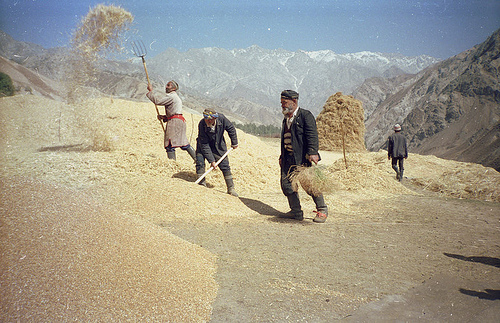
Food Security Problems in Central Asia Challenge Local Regimes
Publication: Eurasia Daily Monitor Volume: 8 Issue: 51
By:

Food security serves as an indicator of any country’s ability to ensure supply, affordability, and safety of food for its population. But it can also be a barometer, testing the effectiveness of public institutions and legitimacy of governments. In the case of the landlocked Central Asian states, this barometer is yet to be stabilized amidst rising global food and fuel prices, the region’s widespread poverty, inflationary pressures, lack of cooperation on water and trade, macroeconomic stability issues, difficult climatic and geographic conditions. The food security reports recently issued by the United Nations and the World Bank reinforced this task, warning of the potentially negative socio-political consequences for the region. The Andijan uprising in Uzbekistan in 2005 and two governments overthrown in Kyrgyzstan in the last six years highlight the potential for related destabilization, calling for urgent reforms across Central Asia.
On February 15, the Head of the World Bank, Robert Zoellick, stated that global food prices have reached “dangerous levels,” cautioning that this could negatively affect Central Asia. “Central Asia is a region where these food prices have increased substantially and given the poverty levels … there is a real stress point that could have social and political implications,” Zoellick suggested (Interfax, February 15). On February 3, the UN global food price monitor reported a rise in prices for basic foodstuffs across the region (www.fao.org, February 3).
In Tajikistan, the situation is portrayed as critical. One year ago, Tajik President Emomali Rahmon, reportedly called on the country’s population to stock up on major food products for at least two years. According to some sources, the price for only one product (flour) has recently increased by 80 percent. This is when 60 percent of an average Tajik family’s diet consists of breadstuffs. Tajikistan’s own food production currently covers 70 percent of its consumption. The government decided to use its strategic grain reserves to reduce grain prices by 15 percent and examine the price formation in the grain market. While remittances can pay for the necessary imports and the country could use its uncultivated lands (more than 50,000 hectares of abandoned plots) to boost agricultural production, some experts point to the questionable sustainability of these approaches (www.news.tj, February 17; www.ca-oasis.info, February 2011).
The instability that swept Kyrgyzstan in 2010 has exacerbated the local food security situation. Struggling to revive its damaged economy, the country now also confronts spikes in food prices of about 20 percent to 30 percent in Bishkek and up to 50 percent to 100 percent in the provinces. Kyrgyzstan imports 35 percent of its food, while its grain consumption is covered to the level of 73 percent. Additionally, 70 percent of local farmers face financial and technical work difficulties (www.24.kg, February 17). Local experts now consider using grain stocks and concessional lending to stimulate agricultural production. “Ayil Banka” bank alone forecasts the allocation of 1 billion soms ($21.74 million) for farmers at a 9 percent annual interest rate. But the parliament is yet to adopt food security legislation as the first of its kind after failed attempts in 2007 and advance coordination among the eleven agencies now actively preoccupied with tackling the food security issue (www.ca-oasis.info, February 2011).
Food security conditions in Turkmenistan are also aggravated. The desert terrain and arable land use of 4.5 percent suggest that crop cultivation is difficult in the country, especially because Turkmenistan relies on upstream countries for 95 percent of its water resources. But production targets set by the state are reportedly fulfilled. Last year, the country produced 1.4 million tons of wheat, although other estimates put the figure at 800,000 tons (www.ca-oasis.info, February 2011; www.cia.gov). This year it aims to produce 1.6 million tons of wheat. The authorities claim that Turkmenistan is already able to export high quality wheat for the first time (www.tengrinews.kz, February 26). But other reports suggest that people often replace more expensive potatoes with pumpkins and that their incomes cannot catch up with rapidly rising food prices, which have increased at least 20 percent to 25 percent (www.gundogar.org, February 3).
In Uzbekistan, food security has been associated with government attempts to gain self-sufficiency and reduce grain imports from Kazakhstan. Uzbekistan reportedly needs 4 million tons of grain annually for its population of 27 million, while its strategic wheat reserves are now in the range of 400,000 to 600,000 tons (www.ca-oasis.info, February 2011). In 2010, Uzbekistan allegedly collected 7 million tons of grain, but prices have increased more than 100 percent on virtually all foodstuffs over the last year, with retail grain prices jumping by as much as 200 percent. Meanwhile, Kazakh companies have managed to gain control over 90 percent of the Uzbek domestic grain market, which for some experts reflects an “utter failure” of the government’s self-sufficiency policy (www.centrasia.ru, January 4).
Kazakhstan has not been immune to food security challenges. Food price increases vary in the 12 percent to 60 percent range (www.i-news.kz, November 17, 2010). Apart from the rising global food and fuel prices, the country’s membership in the Customs Union (with Belarus and Russia) and the 20 percent increase in tariffs on imports from China have contributed to the increases (www.vesti.kz, January 24; www.ca-oasis.info, February issue). The Kazakh opposition suggests that the early presidential elections scheduled for April 3 reflect food security problems confronting the government (www.rus.azattyq.org, February 21).
There are thus clear differences in food security conditions in the region, but there are also common factors. Regional countries suffer from their landlocked status, relatively weak public institutions and harsh climatic conditions, impeded regional trade, water disputes, and extremely high poverty rates of between 25 percent to 60 percent. They also exhibit a low starting point for economic growth, which partially explains higher inflation rates and food price increases, especially in the oil and gas producing countries of Kazakhstan, Uzbekistan, and Turkmenistan, which could nevertheless benefit from the rise in global oil prices amidst the turmoil in the Middle East.
To improve food security experts suggest the need for the countries and governments to work together as well as domestically, to better curb prevalent corruption and poverty, resolve macroeconomic issues, promote agricultural diversification, and pursue expanded and more efficient regional cooperation on water and trade.




